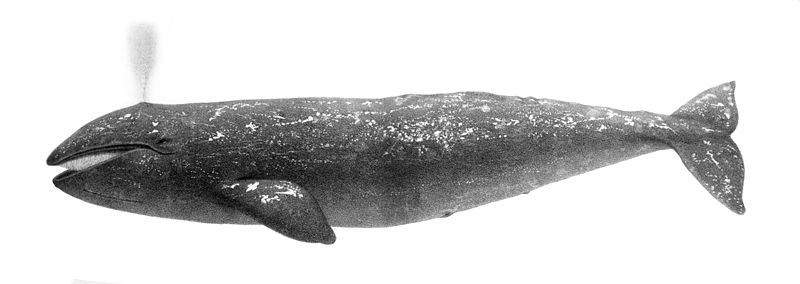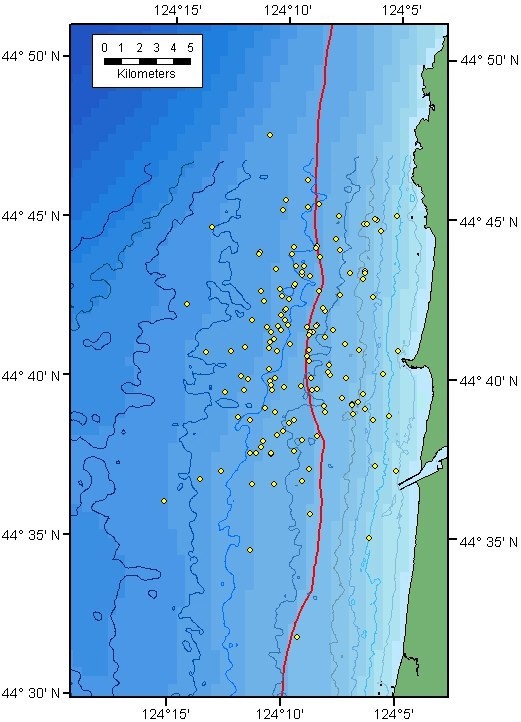Twice each year, east Pacific gray whales (Eschrichtius robustus) swim between their breeding grounds in Baja California and their main feeding areas in the Bering Sea. This round-trip swim of about 15,000 to 20,000 km (8100 to 10,800 nmi) is one of the longest known migrations by a mammal (Shelden et al. 2004). The whales’ migration route is somewhat unusual because it follows very close to the shoreline. This proximity to shore allows scientists to study the migration and permits the general public to observe a large critter. However, the placement of wave parks, such as those proposed for along the Oregon coast, for energy generation in coastal areas along the migration route has raised concern that the parks could interfere with the migration. The primary concerns are that the whales would change course to avoid the wave parks, which could increase susceptibility to predation, increase the energy expended during the migration, or decrease feeding opportunities (Thompson et al. 2008).

The gray whale (Eschrichtius robustus). Illustration by Charles Melville Scammon (1872; Natural History of the Cetaceans and Other Marine Mammals of the Western Coast of North America, with an Account of the American Whale Fishery. J. H. Carmany & Company, San Francisco)
Gray whales feeding in the Bering Sea begin the southerly trip in late fall, with most passing by the Oregon coast in December and January (Ortega-Ortiz and Mate 2008), arriving at their Baja breeding grounds in early winter. Adult males, newly pregnant females, and immature whales begin the northward swim back to the feeding grounds in late winter. A few weeks later, mothers and newborn calves begin the journey. Northbound whales pass the Oregon coast from late February to late May, with the peak occurrence from late March to early May (Ortega-Ortiz and Mate 2008). The northbound migrations generally are closer to shore than the southern trip although there is overlap. A study in 2007 and 2008 along the Oregon coast (Ortega-Ortiz and Mate 2008)found that the average distance offshore during the southbound trip was about 6.6 km (3.6 nmi) offshore although the width of the migration corridor used by most whales ranged from about 5.5 to 7 km (3.0 to 3.8 nmi). During the northbound swim, most whales are from about 2 to 6.5 km (1.1 to 3.5 nmi) offshore and individual whales tend to swim along a relatively constant water depth rather than follow the coastline.

Gray whale groups (yellow circles) observed on scan surveys off Yaquina Head during the northbound migration of mothers and calves (April 7-May 29, 2008). The red line marks the boundary of the State of Oregon territorial sea. (From Ortega-Ortiz and Mate 2008)
The wave park proposed for the Oregon coast would be located 4.6 km (2.5 nmi) off Reedsport (FERC 2010), well within the gray whale migration path, particularly for northbound whales. The park eventually would contain ten wave buoys spaced 101 m (330 ft) apart encompassing an area of 12.1 ha (30 ac). The width of the park presented to the migrating whales probably would be no more than 305 m (1000 ft). Water depths at the park range from 50 to 69 m (165 to 225 ft). Although the ability of the whales to detect the array at a distance, it seems likely that many whales encountering the park likely would swim around it. Whales swimming through the array would risk collisions with the buoys or cables in the array, but the possibility of injury could be relatively small (FERC 2010). Some of the whales that swim around the array would alter course to shallower waters closer to shore, whereas others would head for deeper waters farther offshore. A whale heading for the center of the park would have to detour the farthest, 150 m (492 ft) to swim away from the park and 150 m back to get online (if it even did so). The more distant that the park was detected as a “barrier,” the less detour would be needed to get around it. No doubt some whales would attempt to swim through the park. Wave parks could increase gray whale susceptibility to predation by making them swim into deeper waters. The killer whale is one of the main gray whale predators (Barrett-Lennard et al. 2011). Migrating gray whales that cross the deeper waters over Monterey Canyon in California are often attacked by killer whales who try to separate calves from mothers (Ternullo and Black 2002). Killer whales appear to gain an advantage at the boundary of the steep canyon wall. Gray whales respond to attacks by moving into shallower water, if possible, where the killer whales will often stop the attack (Barrett-Lennard et al. 2011). Given the projected size of the Oregon wave park and the whales’ normal path through the area, any whale detouring around the wave park would still be within the boundaries of the normal migration route and would be no more susceptible to predation than other whales traveling along that path. Forcing whales to detour around wave parks could increase energy expended during migrations, which could increase the whales’ stress because they do not feed much while migrating (Thompson et al. 2008). The energetic cost of swimming has been estimated for a gray whale calf at about 0.5 to 0.6 joules per kg per meter (de la Gala-Hernández et al. 2008). For an average calf (4400 kg), the energy required to swim 1 km would be about 2,200 to 2,640 kJ per km, which extrapolates to about 33,000,000 to 52,800,000 kJ for the northbound migration. Presume that a detour would cause the whale to swim an extra 1 km (0.5 nmi), which probably is an overestimate given the size of the planned park at Reedsport, the energy expended for that swim would be about 2,200 to 2,640 kJ per calf, which is trivial versus the total required. Based on an average swimming speed of 5.6 km/hr, which measured for a whale swimming a relatively long distance (Mate and Urban-Ramirez 2003), the estimated minimum time for a whale to complete the northbound part of the migration would be about 112 days. Based on the same swim speed, detouring around a wave park would add about 11 minutes to the migration. Gray whale cow-calf pairs swim at a speed of 4.4 km/hr (de la Gala-Hernández et al. 2008), so that avoiding the wave park would add about 14 minutes to the total migration time of at least 142 days. Wave parks could interrupt gray whale feeding opportunities. Migrating gray whales feed somewhat sporadically, but some whales leave migratory routes to feed in shallow, coastal waters (Dunham and Duffus 2001, Newell and Cowles 2006). Whales that leave the migration feed in Oregon waters from about May through October and have been called summer residents. Summer residents spend at least two days feeding in coastal waters and return to them in successive years. Resident whales primarily feed on dense swarms of mysids, small planktonic shrimp-like crustaceans, and porcelain crab larvae that typically occur in waters that range from 2 to 15 m (6.6 to 49 ft) deep and are within 0.6 km (0.3 nmi) of shore (Newell 2009). The proposed Reedsport wave park is farther offshore and in deeper waters than where mysid swarms form. Evidence gathered to date indicates that the proposed wave parks should not adversely affect migrating, or summer-resident, whales by increasing their susceptibility to predation, increasing energy requirements, or interrupting feeding behavior.
